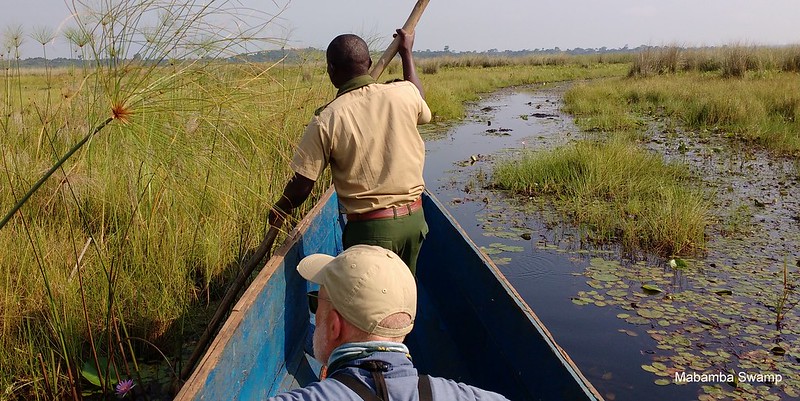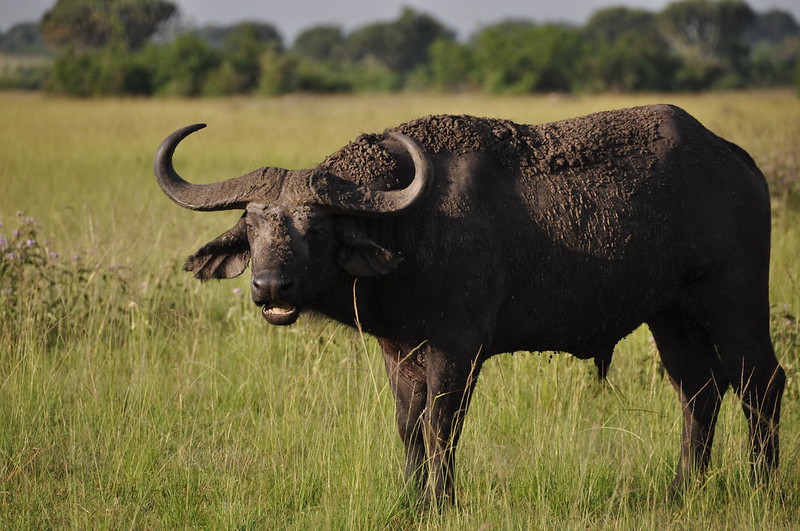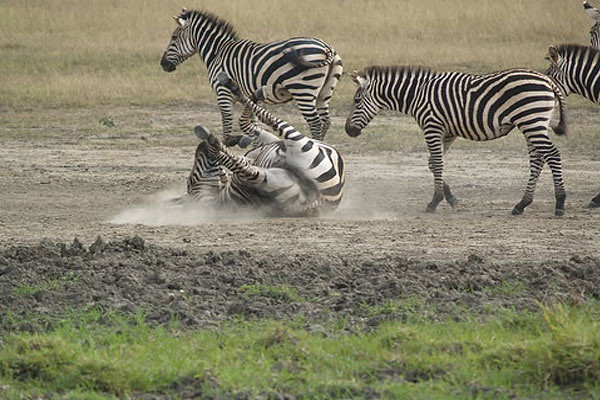Mabamba Swamp Birding Adventures. Tourists and birdwatchers go to Uganda's Mabamba Swamp Birding Adventures to…
Birds in Uganda
Birds in Uganda, Over 1,090 species of birds have been seen in Uganda, making the country’s bird population very varied. The list also has bird species that are in danger of going extinct, such as the rare Shoebill.
You will see the Orange-breasted Waxbill, the Chapin’s Flycatcher, the Grant’s Bluebill, the Grey-winged Robin-Chat, and the Papyrus Yellow Warbler on your Uganda birding tour. African harrier hawks, Eurasian Hobby, Red-throated Flycatchers, White-tailed Lark, Cinnamon-breasted Rock-warbler, and Papyrus Yellow Warbler are some of the other birds that live there.
Some species live in the area and some African countries. For example, Ground Hornbill, Great White Pelican, Martial Eagle, Crowned Hornbill, Palm-nut Vulture, and Black-headed Gonolek are regular species, while White Storks, Black Kites, and Spotted Flycatchers are palearctic migrants.
Shoe Bill Stork
This African bird, the Shoebill Stork (Balaeniceps rex), is in danger of going extinct. In tropical east and southeast Africa, it lives mostly in swamps and marshes. Shoebill storks are mostly seen in Uganda, especially around Lake Victoria. This is because they like to live in marshy areas. You can see this bird in the Mabamba swamp, which is near Lake Victoria. People who go on the Mabamba Swamp walk can get up close and personal with many bird species, including the rare shoebill stork.
Waxbill with orange breasts
The Estrildidae family includes finches, sleeves, and munias, as well as the orange-breasted waxbill. This species is common and can be found in a lot of places. This species often lives in the grasslands, woods, and forests of Uganda’s savanna.
Its head and back are bright orange, and its other parts can be yellow or green. This bird gets its nutrition from eating bugs, worms, and seeds. Its name comes from its orange breast.
The Flycatcher by Chapin
People don’t worry too much about the Chapin’s Flycatcher’s conservation status because it lives in a large area and its number stays pretty stable. This bird lives in a lot of different places, from swamps to woods and savannahs. In spite of its name, it can sometimes be found at much higher levels than you might think. This bird lives in Uganda. You can see it in places like Pian Upe Nature Reserve and Murchison Falls National Park.
Pitta with a green breast
The Green-breasted Pitta can often be seen in Uganda’s forests, especially in Kibale National Park, Maramagambo Forest, and some places of Bwindi Forest National Park. The species can also be found nearby along the Albertine Rift. The bird lives in thick greenery, is shy, and keeps to itself. You might hear its call but not see it because it is so private. Its call is a loud whistle that rings out or has two or more notes. From April to October, when it rains a lot, is the best time to find this species because it is more busy and active.
Green Broadbill in Africa
The African Green Broadbill lives in different places in East Africa, Western Africa, and Central Africa. To find it, look in rain forests and woods near the Nile River and other bodies of water. The African Green Broadbill usually eats food, bugs, and nectar.
African Green Broadbills are going rare because of many things. Some of these are ecosystem loss from cutting down trees and separating habitats, hunting for food, and the pet trade. For the past nine years, the African Green Broadbill has also been on the IUCN Red List of Threatened Species as Vulnerable.
Saddle-Billed Stork
You can find the Saddle-billed Stork, which is a big species of tropical stork, in the eastern and southern parts of Africa. It is also sometimes called the Senegalese Stork. When it comes to food, the Saddle-billed Stork likes to eat fish, frogs, and insects. Its favorite places to be are marshes and shallow lakes in Uganda.
There are no threats to the saddle-billed stork. It’s not in danger, says the International Union for Conservation of Nature (IUCN).
Do not dismiss this beautiful bird. It can grow up to 1.5 meters tall over the course of its life. A man typically weighs 7 kg, while a woman typically weighs 5 kg.
It has very long legs, measuring almost 40 cm long. Their beaks can get up to 35 cm long! Its wings are about 2.5 meters long, but they can be even longer.
The long legs of the saddle-billed stork are useful, not just pretty. It makes it more likely that they will be successful in what they do.
The first thing they can do is wade through pretty deep water to find food. Long-legged water birds, like saddle-billed storks, move through shallow water so elegantly. They can reach deep into the water to find food with their long bills.
The Goliath Heron
There are many Goliath herons in Sub-Saharan Africa, mostly in the south and west. They are big gray herons. This species lives in Uganda, where it can be found in marshy areas, along the edges of lakes, and in open forests. Its main food sources are fish, frogs, and other aquatic animals, but it can also eat bugs and mice. It has been seen sleeping in big trees near water.
Are there risks to Goliath Herons? Goliath herons are not in danger of going extinct. The International Union for Conservation of Nature (IUCN) says that Goliath herons are the least of a worry.
African Fish Eagle
The African Fish Eagle (Haliaeetus vocifer) is a big eagle that lives in sub-Saharan Africa. Its unique sound, a high-pitched “quet-quet-quet,” can be heard in many of Uganda’s marshes and open spaces near bodies of water where this species lives. African Fish Eagles, which are also called African Fish Eagles, are one of the most well-known birds in Africa.
They live mostly in the plains and marshes in the western and northwest parts of Uganda, as well as around Lake Victoria. They are called Haliaeetus vocifer, which in Latin means “sea eagle with a loud voice.”
The African Fish Eagle is a big bird. Its wings are almost two meters long. Big heads and beaks are what they’re known for. Their heads and necks are white, and their backs and tails are darker brown. The adults’ legs are yellow, their claws are black, and their underwings are white. The young, on the other hand, have lighter brown feathers, grey claws, and eyes that are light brown.
The African Fish Eagle mostly eats fish, but it does sometimes catch water snakes, turtles, and other animals that live in water. It floats above the water and dives with its wings closed to catch food. With its strong claws, the bird catches its food and either eats it on a perch or brings it to its nest to feed its young. Most of the time, nests are in big trees near rivers and lakes.
A Big Blue Turaco
Great blue turacos are big, beautiful birds that live in warm and tropical Africa, mostly in Uganda and East Africa. It is one of the most popular turacos and is in the Musophagidae family.
The males are bigger than the females, and their backs have white lines and bright blue feathers. The great blue turaco is pretty busy during the day and eats a wide range of foods, including fruits, nuts, flowers, and small animals.
The great blue turaco is a well-known species of the Musophagidae family of birds because of its very loud calls that can be heard from many miles away. They breed in groups, so high trees are great for breeding. This bird is one of Uganda’s most famous and well-known species. Its beauty shows how varied and unique Uganda’s nature is. Africans believe that the Great blue turaco brings love, peace, and luck. It is an important part of their culture.
Long-tailed Eagle
The Long-crested Eagle (Lophaetus occipitalis) is a big bird of prey that lives in Uganda and other countries in sub-Saharan Africa. It can be told apart from other birds by its long crest, rufous back and head, and brightly striped underside. It has wings that can spread out up to 1.8 meters and weighs up to 1.3 kilos. It is very common to see a long-crested eagle in Uganda. It is especially common along the roads, especially the Entebbe Express highway around Nambigirwa swamp.
Even the helmeted guinea fowl is one of the many birds, mammals, and animals that it eats. It nests in tall trees and has two to three eggs during the dry season. Its small numbers in East Africa are in danger because of habitat loss and hunting. This is especially true in the Democratic Republic of the Congo, where bush meat and habitat loss put the birds at risk. In Uganda, it is now a protected species, and anyone caught killing it can go to jail.
The Bird That Answers
The Secretary Bird is a big bird that lives in the savannahs of Africa and stays on the ground most of the time. People think the bird’s name comes from the big crest of feathers that looks like a quill pen, which makes people think of a secretary sitting at a desk. River Nile, Kidepo Valley National Park, Murchison Falls National Park, and Pian Upe reserve are the main places in Uganda where you can see Secretary Birds.
The secretary bird is usually seen as a sign of strength and bravery in some African cultures. Because they are good hunters, their strong feet make it easy for them to sneak up on and kill snakes, rats, lizards, and other small animals. A female secretary bird will lay three eggs during the laying season. Unlike some other bird species, they only mate once.
Because they have long legs, Secretary birds can fly 44 miles per hour, which is pretty fast.
Black Bee Eaters
Black Bee Eaters are a type of bee-eater that lives in Uganda’s open and bushy forests, savannahs, and grasslands, where they do very well. This species is pretty common in Uganda. It eats bugs like termites, bees, and wasps. In Murchison Falls, National Park, the Black Bee-eater usually builds its nest in holes in high banks on open slopes next to water or on sandy riverbanks.
It lives in Bwindi Forest and the forests along the Kyambura and Ishasha rivers in the western part of Uganda.
In Uganda, the Black Bee Eater is one of the 12 most-wanted bee-eaters. In Uganda, keep an eye out for the Black Bee Eater. It is a very pretty bird. It is a good idea to add it to your list.


